Concept and Creativity
By Sehba Mohammed | Art | Arts & Culture | Published 14 years ago
Some art works speak to the senses; others resonate with the intellect. Karachi’s burgeoning art scene has had many artists who have left a visual imprint, but it is only when one scratches the surface that the vast layers of meaning behind the images are unveiled. Two recent group shows at the Poppy Seed and Canvas galleries brought the richness of concept to the art-viewing public. All of the relatively unknown artists on display used ideas as a driving force behind their work.
The Poppy Seed Gallery lies like a hidden gem on the first floor of the graying, paint-peeling Shafi Court building. Once inside the gallery, you instantly forget the paan-stained stairs you had to climb to get there. The clean bare open space entices you with its simplicity. If the Chawkandi and VM art galleries set the foundation for gallery culture in the city, then places like Poppy Seed are a natural progression, where art jumps off the walls in the form of poetry-readings and live demonstrations.
The work on display in the current group show titled Revisited echoes curator Sumbal Khan’s sentiments for a more democratic inter-disciplinary form of art. All the artists on display are high school art educators, dedicated to moulding the aesthetic sensibility of future generations. This exhibition allows them to re-examine their own art practices.
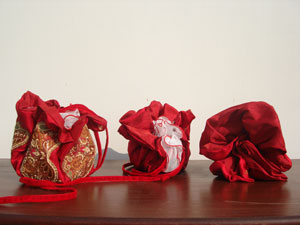
Zairah Maher’s crimson work is ripe with feminist notions.
Each of the three artists have distinctive styles and explore different mediums from pencil-renderings to embroidery. Although each piece has aesthetic appeal, one cannot completely understand or appreciate them without discovering the intricate concepts behind them.
Adnan Lotia, an O-Levels art teacher, is an extremely experimental and conceptual artist. However, in this exhibit he deviates from the norm, producing work which focuses on skill rather than thought. The six basically composed graphite-rendered portraits on display are all members of the artist’s family, from his paternal grandmother to brother. The drawings are an uncomplicated marriage of simplicity and skill, with each strand of hair charged with emotion and each wrinkle skillfully carved out. However, in the artist’s own words, “If I saw this work in a gallery I might detest it.” This paradoxical statement reveals Lotia’s intention behind the series: to step into the shoes of his O-Level art students and understand their plight by producing work where the emphasis is on proportion, skillfulness and use of medium then is stripped of concept, theory or idea.
An A-Level art teacher, Zairah Maher’s crimson work is ripe with feminist notions. It explores the female form and psyche through metaphors. In the piece titled “Yummy Mummy,” she uses three delicate silk and organza bags to make an uncanny representation of a uterus at different stages of child birth.
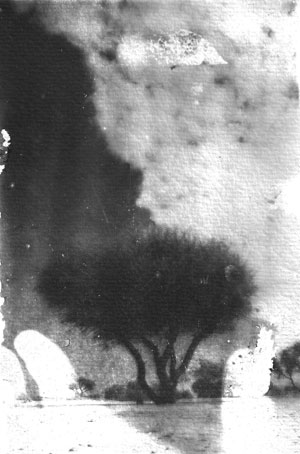
Sohail Abdullah creates dream-like experimental photographs.
In another piece, the artist uses embroidery as a medium, reminiscent of the 1970s’ feminist artists in the US, who tried to elevate domestic crafts like sewing and embroidery to the realm of fine art. For Maher, the process of making the pieces is as important as the final outcome. Covering a rectangular frame representing a female form, with muslin and rabbit glue to create a thick workable surface, she uses a sharp needle to embroider organic pomegranate patterns. For her, the act of piercing the needle into the thick surface is symbolic of the sexual act.
The last artist on display uses photography which goes beyond the mere realistic rendering of a subject. Sohail Abdullah’s series of dream-like experimental photographs delves into the concept that a photographic image does not really capture the true essence of a moment but, in fact, taints memories by taking away all their tactile qualities. His manual photography techniques are experimental, ranging from long exposure to photograms, which are photographic images made without a camera. The effect created is that of a negative or an X-ray. Abdullah chooses to use baby clothes stitched by his mother for his photograms, creating a striking and sinister feeling of innocence lost.
* * *
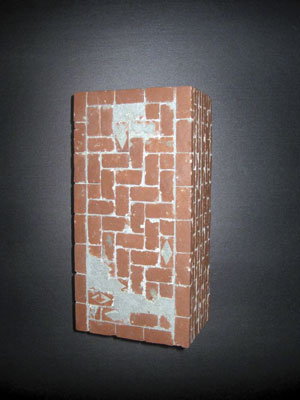
Noor Ali Chagani’s red-brick sculptures represent desire.
A further search for rich concepts behind pieces of art led me to the Canvas Gallery, which has always felt the pulse of the contemporary art scene, bringing together talent not just because of the quality of work but also the consistency in style.
The four-person show on display brought the work of NCA graduates together. Each one of the artists had personally developed distinct styles, and each piece was visually unique while the concepts behind the work ranged from the personal to the political.
Red bricks are a significant part of Punjab’s aesthetics, but for the artist on display, Noor Ali Chagani, whose art pieces are rectangular sculptures made out of miniature terracotta bricks, it means something more. This engineer moved to Lahore to obtain a degree in fine arts. Here, he came face to face with Lahore’s endless avenues of red brick houses. They were a symbol of affluence, safety and order, and Chagani identified with them. He calls himself a simple man and says that his pieces symbolise the desire — similar to that of most Pakistani men — to have a nice house and a beautiful wife. He also focuses on investigating the ideas of ownership and unity in society. The rectangular brick structures vary in type. One of them is immersed in cement so that only a few red bricks can be seen peeping through. In another, the tiny brick replicas lie haphazardly piled on top of each other with cement oozing out of the cracks like an angry beast. According to Chagani, the latter piece represents most building structures in Karachi, which are built without any planning or order.
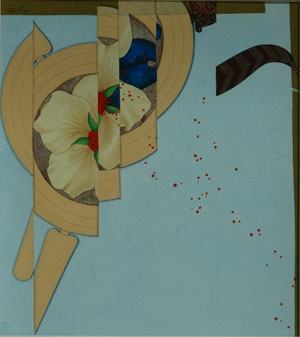
Attiya Shaukat, a miniaturist, delves into the deep pain associated with a physical injury.
Most of the work on display personifies the personal journeys of the artists. Attiya Shaukat, a miniaturist, similarly delves into the deep pain associated with a physical injury. Her story takes us back to Frida Kahlo, the famous Mexican artist who, after suffering from a spinal injury, expressed her suffering through her paintings. Shaukat’s work is nowhere near as vibrant and vivid. Instead, she chooses to explore her pain in a muted and subtle way, carrying her burden like a demure South Asian woman. There is, however, a powerful detailed tranquility to her work. Seven years ago, Shaukat had a painful accident which injured her spine. A metal plate had to be inserted in place of a vertebra. Since then, her miniature work has been less about traditional floral patterns and more about the relationship between organic and metallic forms, and how they can work together in harmony. In one of her gouache on vasli pieces, there is a perfectly rendered vertebral column on a pale background. The likeness is eerie as it floats in the centre of the painting, challenging you. One of the vertebrae is painted a steely blue, representing the metal in the artist’s backbone. The bone and metal in the painting are held together by a symbolic red thread. Another piece which emphasises the artist’s exploration of mechanical and organic forms is that of an ancient warrior’s armour in which the metallic plates have been made to follow the curves of a human body.
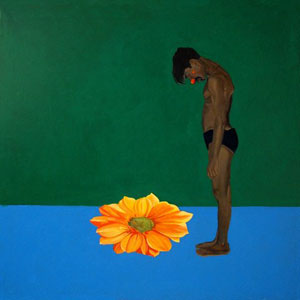
Naseer Bhurgri does not believe in talking about his work.
The four-person show did not only capture four different ways of seeing but also glimpsed into four different genres: sculpture, miniature, painting and drawing. The painter on display, Naseer Bhurgri, does not believe in talking about his work. For him, part of the beauty of art is the meaning that the viewer adds to the painting, and his work often speaks for itself. It is a visual treat, striking, free and bold, yet quiet and self-conscious. All the pieces are figurative works. The model uses a thin, effeminate, coffee-skinned man, bare except for his blue underwear. His skin taut, so you can see beneath it the tenseness of the muscles as the figure strikes a particular pose. A guise of simplicity covers the detailed human forms. What really brings the figure out is the fresh and vibrant backgrounds: a flat wash of yoke yellow behind a sombre figure contemplatively putting his head down; candy pink and forest green behind a man crouching, head buried in his knees. The artist plays around with basic colour and composition and his seemingly vibrant work exudes feelings of isolation and not being comfortable with one’s surroundings.
The last artist on display, Imran Mudassar, has had an interesting artistic career: he has helped organise events all over the world including Afghanistan, Singapore, Oxford and Gojra in the Punjab, assisted in the set-design of the renowned film Khuda Key Liye and exhibited widely in Pakistan. His drawings are a pacifist’s message of peace. He deals with the ideas of life, and the destruction of life by placing images of his own body next to war-related objects, creating a dialogue between his own form and the ruin of war. The artist’s skill level is immaculate. His self-portraits are honest, down to the last chest hair. But real evidence of his craftsmanship comes to light in the details he effortlessly puts into the different forms of armour. He highlights each petal of the floral pattern engraved on the breastplate of the metallic body-covering. His minimal use of colour and simplicity may come across as bland, but they are a stark reminder of man and the many self-deprecating creations which he has constructed.
There is immense versatility in the creativity that is pouring out of every corner of Pakistan. Not just in terms of the visuals and mediums that these talented artists choose to use but also in the vast array of concepts that are the driving force behind their work.


